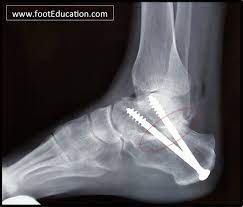
A subtalar joint arthrodesis is a surgical procedure in which the subtalar joint, which is located between the heel bone (calcaneus) and the ankle bone (talus), is fused together to create a single, solid bone. This procedure is typically performed to treat conditions such as severe arthritis, instability, or deformity of the subtalar joint.
During the procedure, the surgeon makes an incision on the side of the foot and removes the damaged cartilage from the subtalar joint. The bones are then positioned in the desired alignment and held in place with screws or other hardware. Over time, the bones grow together and fuse into a single, solid bone.
Subtalar joint arthrodesis is typically performed under general anesthesia and requires a period of immobilization in a cast or brace. Physical therapy is also recommended to help regain strength and mobility in the affected foot. While this procedure can be highly effective in treating certain conditions, it does limit the range of motion in the foot and ankle and may lead to an increased risk of arthritis in adjacent joints over time. It is important to discuss the potential risks and benefits of subtalar joint arthrodesis with a qualified healthcare professional before undergoing the procedure.
